Our Roots Are Still Alive - Chapter 3
Previous: Chapter 2
Table of Contents
Next: Chapter 4
New Jersey Solidarity-Activists for the Liberation of Palestine Main Site
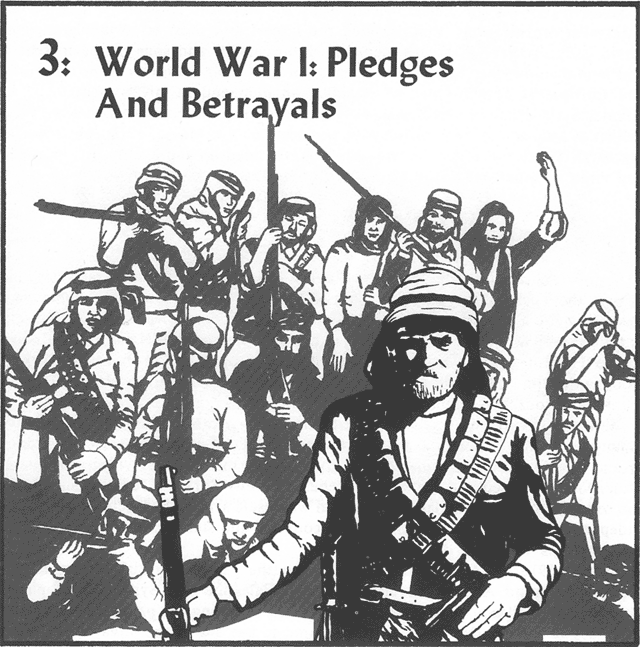
- On October 1, 1918, Arab and British troops liberated Damascus. After 400 years of Turkish rule, Greater Syria was independent at last.
For soldiers and civilians, the battlefields of World War I were vast scenes of death, disease and starvation. Eight million soldiers died in the blood-soaked trenches of Europe. In Greater Syria, one-eighth of the population died of starvation. But for the empires of Europe, the war was a necessary means of re-dividing the world. The decaying empires of Turkey and Austro-Hungary were the biggest prizes. Both Britain and France coveted the Turkish colonies in the Middle East.
Britain acted quickly to gain the inside track. Throughout the first year of the war, the British forged an alliance with Sharif Hussein, the ambitious Arab ruler of the Hejaz, the eastern coast of the Arabian Peninsula. Britain promised to make the Arab countries independent after the war if Hussein would call for an Arab revolt against the Turks. Sir Henry McMahon, the British Consul in Cairo, wrote several letters to Hussein, detailing the lands that would become independent. They included Palestine.1
Hussein sent his son Feisal to Damascus and Beruit to contact the secret Arab nationalist organizations. Feisal joined the largest and most important group, al-Fatat, early in 1916. Al-Fatat's members, professionals and sons of the merchant and land-owning class, wanted to wrest control of their countries from the Turks and Europeans. They wanted to establish an independent government in all of Greater Syria. Hussein and Feisal, as feudal leaders, preferred an alliance with the British as long as their personal power was secured. On May 5, 1916, Jemel Pasha, the harsh Turkish overlord of Greater Syria, rounded up and executed twenty-one key Arab nationalists, including leaders of al-Fatat.
The Arab Revolt
On hearing news of the executions, Feisal called for all Arabs to take up arms against the Turks. After years of repression by the Turks, the Arab people were ready to fight. That June, the Arab Revolt began, under the leadership of Hussein and Feisal. By late 1916, Arab troops had captured most of the Hejaz and laid siege to the Turkish garrison at Medina, pinning down over twelve thousand Turkish troops until the end of the war. Arab attacks on the Hejaz railway slowed Turkish communications and supplies.
Within the Turkish army, massive desertions by Arab soldiers ground military actions to a halt. Throughout Greater Syria, the official press suppressed all stories of the rebellion, but the news spread by word of mouth from village to village. Desertions increased and the spirit of rebellion grew. Enraged, Jemel Pasha placed the country under martial law and ordered wholesale arrests. Suspected members of the independence organizations were beaten, confined and starved. But the secret Arab organizations were not destroyed.
By late 1916, as Arab soldiers held down the Fourth Turkish Army, British General Edmund Allenby advanced through Palestine and Syria. British planes showered the villages of Palestine with leaflets reminding the people of the British promises of independence. Palestinians came to the aid of the advancing British. Entering Jerusalem, the British received a warm welcome from the population, which had shrunk to half its pre-war size from starvation and emigration. Hundreds of people in Jerusalem jammed recruiting stations to join the Arab Army.
On October 1, 1918, Arab and British troops entered Damascus. A government had already been formed. The flag of the Arab Revolt was flying, and the people of the city celebrated their long-awaited liberation from the Turks. For the people, it was more than an end to the famine and murder of the war years. Greater Syria was independent at last. Or so it seemed.
The British had won their military victory in the area by promising support for Arab independence. But from the beginning, they never intended to honor their pledge. In 1916, as McMahon wrote his promises to Hussein, a French and a British official met secretly to negotiate the fate of Greater Syria. Sir Mark Sykes of the British War Office and Henri Picot, French Consul of Beruit, planned the dissection of the area after the war. Under the plan, known as the Sykes-Picot Agreement, France was to receive most of present-day Syria and Britain most of present-day Iraq. Both powers wanted Palestine. They compromised on a proposal for an international administration. This betrayal of British promises was kept hidden from the Arab peoples during the war.
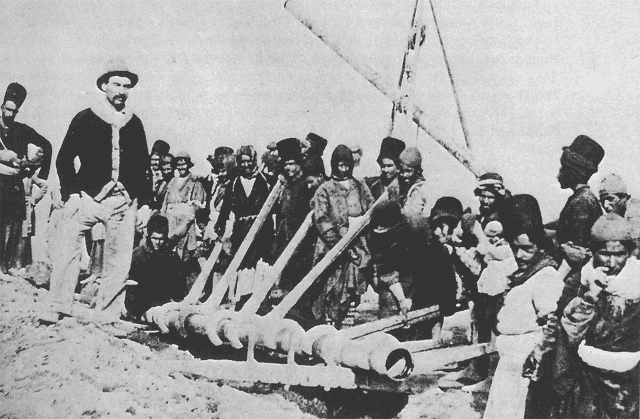 Arab workers lay pipeline for the British. By the peginning of World War I, the British viewed Middle Eastern oil as an important prize.
Arab workers lay pipeline for the British. By the peginning of World War I, the British viewed Middle Eastern oil as an important prize.
The Balfour Declaration
Britain was equally prepared to betray the French. Palestine was too valuable to share with a less powerful ally. British diplomats resolved to use the Zionist movement to gain full control of Palestine. The Zionists understood their potential role in the British Empire. Chaim Weizmann, the Zionist leader, wrote a 1914 letter to a British newspaper:
- [S]hould Palestine fall within the British sphere of influence and should Britain encourage Jewish settlement... [we could] develop the country, bring back civilization to it and form a very effective guard for the Suez Canal.2 [emphasis added]
In February of 1917, Chaim Weizmann and Sir Mark Sykes sat down to work out an agreement. Weizmann guaranteed that the Zionists would accept only British control of Palestine in return for an official expression of British support for Zioinst settlement in Palestine.3 Throughout the spring and summer of 1917, British statesmen and Zionist leaders worked on the British declaration of support for Zionism. The first draft stated:
- His Majesty's Government accepts the principle that Palestine should be reconstituted as the national home of the Jewish people... and will be ready to consider any suggestions on the subject which the Zionist organization may desire to lay before them.4
The draft was reworded several times to find a version that didn't offend English Jews, many of whom opposed Zionism. The largest Jewish organization in England strongly protested against the declaration because it "must have the effect throughout the world of stamping the Jews as strangers in their native lands."5 The final version of the declaration was a compromise. The Zionists' real goal - the Jewish state - was concealed in the diplomatic term "national home." On November 2, 1917, the declaration was released publicly in the form of a letter from Lord Balfour of the British government to Lord Rothschild, a wealthy English Jew.6 It read:
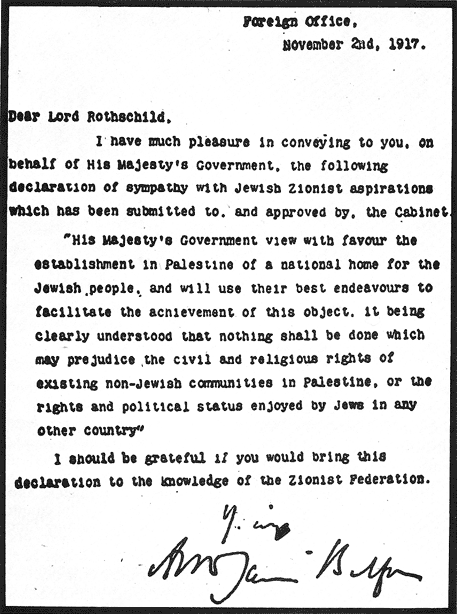
The Balfour Declaration was meant to be kept secret from the Palestinian Arabs, the "existing non-Jewish communities" in Palestine that were 93 percent of the population and owned 95 percent of the land! On the other hand, British planes dropped copies of the Declaration over cities in Russia and Eastern Europe which had large Jewish populations. Britain hoped the Declaration would win Russian Jews to the war effort and help stem the tide of revolution against the Czar.
But five days after the publication of the Balfour Declaration, the Russian revolution swept Lenin and the Bolsheviks into power. The rule of the Czar was ended forever. The Bolsheviks knew that the workers and peasants had nothing to gain by continuing to fight in a war between imperialist powers. Russian soldiers left the trenches and returned home. The new Soviet government withdrew from the war, and announced its peaceful intentions towards the previously colonized people of the Middle East and Asia:
- Henceforth, your beliefs and customs, your national and cultural institutions are decreed free and inviolable... We declare that the secret treaties of the dethroned Czar... are now null and void.7
As the Bolsheviks had pledged, the Soviet government published all the secret agreements that Russia had made under the Czar. They released a copy of the Sykes-Picot Agreement and news of the Agreement filtered through to the Arab countries. Soon, the Palestinians also learned of the Balfour Declaration.
The first Arab reaction to the Sykes-Picot Agreement and the Balfour Declaration was disbelief. The Arabs had fulfilled their part of the bargain with Britain by fighting long and courageously against the Turks. Hussein demanded immediate clarification from Britain. In a series of telegrams, letters and meetings, the British tried to pass off the news of the Agreement as a Bolshevik lie and a plot by the Turks and the Germans to fool the Arabs. The British renewed their pledge of self-determination.
The end of the war in November of 1918 revealed the real value of this pledge. France, Britain and the United States, the late-comer into the war, were the victors. They organized the Versailles Peace Conference in January of 1919. When Feisal arrived in Europe as the Arab delegate to the conference, his worst fears were confirmed. The "imaginary" Sykes-Picot Agreement emerged as the subject of a heated debate between the British and the French. The British, stronger than ever after the war, wanted a bigger slice of the Middle East - complete control of Palestine and the Mosul oil fields in Iraq. The use of tanks, planes and ships in World War I had created a strong demand for secure sources of oil, and the British wanted the lion's share of the rich oil fields of the area. They planned to construct a pipeline from Iraq and the Arabian Peninsula to the Palestinian port of Haifa on the Mediterranean Sea.
The Mandate: A Mask for Colonialism
The principle of self-determination, heralded by both Europe and the United States throughout the war, was ignored as the winners began to divide up the spoils of war - the colonies of Germany and Turkey. They created the mandate system, a new name and a new face for colonialism. A nation receiving a mandate would control the land and resources of another people until that people had "progressed far enough along the road to self-government." The nation given the mandate had the right to decide when enough progress had been made.
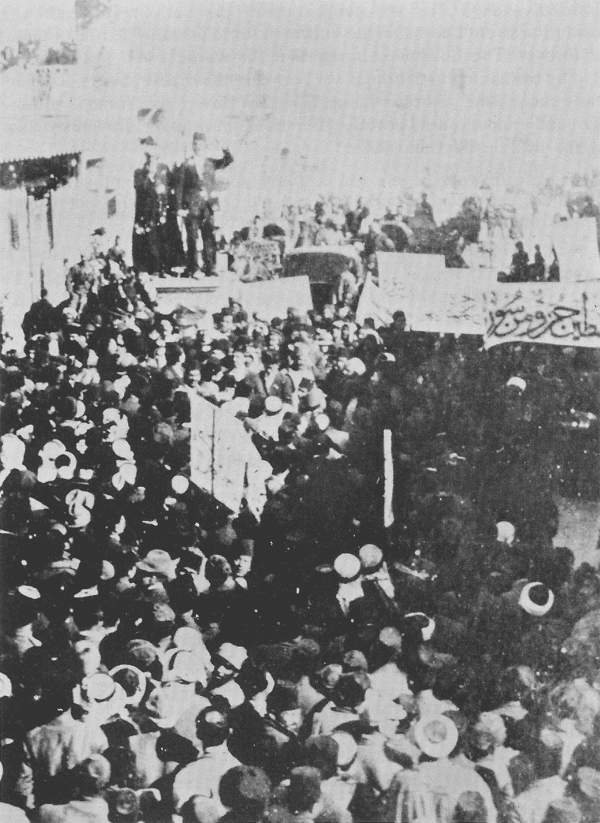
Palestinians protest the reading of the Balfour Declaration in Jerusalem, 1919.
At the peace conference, Feisal denounced the Sykes-Picot Agreement. He submitted a statement to the conference which read:
- As representing my father, who, by request of Britain and France, led the Arab rebellion against the Turks, I have come to ask that the Arabic-speaking peoples of Asia... be recognized as independent sovereign peoples...8
Feisal urged that an international commission visit Syria and Palestine to determine the wishes of the people. Under pressure from President Woodrow Wilson, the conference reluctantly agreed. Wilson wanted an American mandate in the area and hoped that the commission would propose just that. He immediately appointed two U.S. representatives, Henry King and Charles Crane, to the commission. Feisal left for Damascus, confident the commission would soon follow.
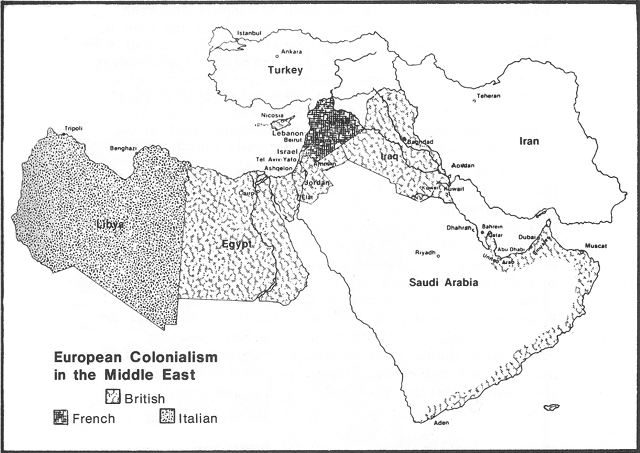
People in Greater Syria organized for their independence. Elections were held throughout Syria, Palestine, and Lebanon for delegates to a national congress. On July 2, 1919, the General Syrian Congress, meeting in Damascus, unanimously condemned the Sykes-Picot Agreement, the Balfour Declaration, and the plans of the Zionists. They put a pointed question to the Great Powers:
- How can the Zionists go back in history two thousand years to prove that by their short sojourn in Palestine they have now a right to claim it an return to it as a Jewish home, thus crushing the nationalism of a million Arabs?9
The Congress denounced the mandate system. It demanded that Greater Syria become one united and independent nation. As the resolutions became known, people demonstrated throughout Syria, Palestine and Lebanon in support of the Congress.
In the meantime, the King-Crane Commission had arrived in Jaffa. It consisted of only the two American representatives; France, Britain and Italy had backed out. The Commission spent six weeks in Syria and Palestine, interviewing delegations and reading petitions. King and Crane recommended an American mandate with two important provisions. First:
- The unity of Syria (Palestine, Syria and Lebanon) ought to be preserved in accordance with the earnest petition of the great majority of the people of Syria.
And second, they recommended "serious modification of the extreme Zionist program." The report stated:
- The commissioners began their study of Zionism with minds predisposed in its favor... The facts came out repeatedly in the Commissioners' conferences with Jewish representatives that the Zionists looked forward to a practically complete dispossession of the present non-Jewish inhabitants of Palestine by various forms of purchase... No British officers, consulted by the Commissioners, believed that the Zionist program could be carried out except by force of arms... The initial claim, often submitted by Zionist representatives, that they have a "right" to Palestine based on occupation of two thousand years ago, can barely be seriously considered.10
On April 5, 1920, Britain, France and the United States met at San Remo, Italy. The findings of the King-Crane Commission were ignored. The United States was not powerful enough to enforce its desire for a U.S. mandate in the Middle East. No government at the conference cared what the peoples of Greater Syria thought or wanted. France received a single mandate for Syria and Lebanon; Great Britain received two mandates, one for Iraq and one for Palestine. The mandate gave Britain a free hand to implement the Balfour Declaration.
But a formal public reading of the Balfour Declaration by a British official in Palestine in February of 1920 had already sparked large demonstrations in Palestinian cities. In April, the month of the San Remo Conference, riots broke out in Jerusalem during Easter Week and Palestinians attacked recent Jewish immigrants. As British officials prepared to govern Palestine, Palestinians had already given warning that they would not accept a British-sponsored settler colony on their land.
Footnotes
- The McMahon Correspondence, cited by George Antonius, The Arab Awakening (New York: 1965), p. 419.
- Letter to C.P. Scott, editor of the Manchester Guardian, November 1914, cited by Taylor, Prelude to Israel, p. 12.
- Antonius, p. 263.
- Leonard J. Stein, The Balfour Declaration (London: 1937), p. 664.
- London Times, 24 May 1917, cited by Stein, p. 454.
- Antonius, p. 266.
- Ivar Spector, The Soviet Union and the Moslem World, 1917-1958 (Seattle: 1959), p. 33, cited in "Soviet Policy in the Middle East," MERIP no. 39, (Washington, D.C.), p. 3.
- Cited by Antonius, p. 286.
- "Syrian Protests Against Zionism," Literary Digest no. 66, 3 July 1920, p. 31, cited in The Transformation of Palestine, p. 58.
- Cited by Antonius, pp. 444-49.